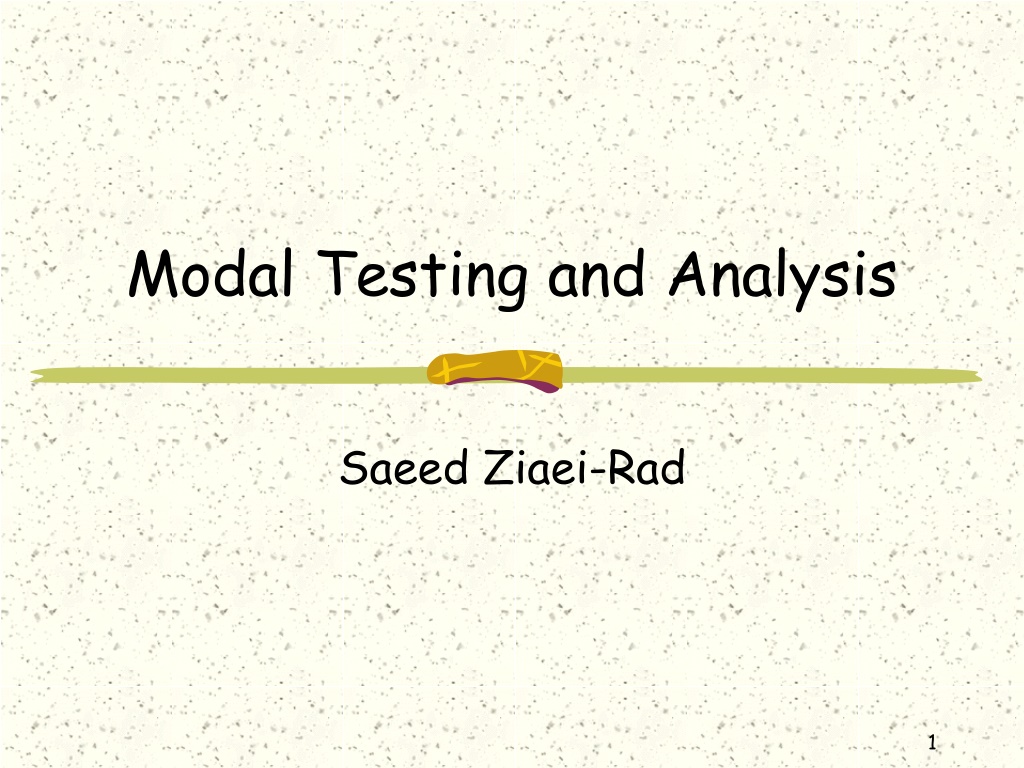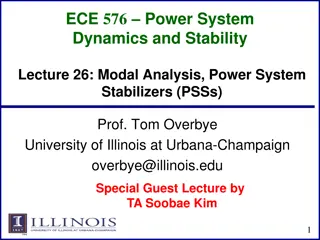Understanding Modal Testing and Analysis in Structural Dynamics
Modal testing and analysis play a crucial role in understanding the behavior of structural systems under various conditions like undamped, viscously damped, and hysterically damped scenarios. This analysis involves the study of single-degree-of-freedom systems, undamped systems for free and forced vibrations, viscous damping for both free and forced vibrations, structural damping characteristics, and alternative forms of Frequency Response Function for evaluating system responses. The content explores the theoretical concepts and practical applications of modal analysis in structural dynamics.
Download Presentation

Please find below an Image/Link to download the presentation.
The content on the website is provided AS IS for your information and personal use only. It may not be sold, licensed, or shared on other websites without obtaining consent from the author. Download presentation by click this link. If you encounter any issues during the download, it is possible that the publisher has removed the file from their server.
E N D
Presentation Transcript
Modal Testing and Analysis Saeed Ziaei-Rad 1
Single Degree-of-Freedom (SDOF) Undamped Viscously Damped Hysterically (Structurally) Damped Modal Analysis and Testing 2
Undamped Systems (Theory) F(t) Spatial Model (Free vibration) m + = 0 m x kx = i t ( ) x t Xe k + = 2 0 m X kX = 2 ( ) 0 k m X = / 1 ) 2 ( / k m 0 Modal Analysis and Testing 3
Undamped Systems (Forced vibration) 1 0.9 + = ( ) m x kx = f t 0.8 0.7 i t ( ) 0.6 x t Xe H( ) 0.5 0.4 i = t ( ) f t Fe 0.3 0.2 0.1 = 2 ( ) k m X F 0 0 2 4 6 8 10 12 14 16 18 20 (Rad/s) 1 m X = = = ( ) ( ) H FRF=Frequency Response Function 2 F k Modal Analysis and Testing 4
Viscous Damping (Free Vibration) + + = 0 m x x c kx = st ( ) x t Xe + + = 2 0 ms cs k = i 2 1 s Oscillatory solution 2 , 1 0 0 = = 2 0 ( / , /( 2 ) k m c km i = t t ) x t Xe e d = = 2 , 1 0 0 d Modal Analysis and Testing 5
Viscous Damping (Forced Vibration) + + = ( ) m ( x x c kx f t 0.1 0.09 0.08 + + = 2 i t i t ) m i c k Xe Fe 0.07 0.06 1 X H( ) 0.05 = = ( ) H 0.04 + 2 ( ) F k m i c 0.03 0.02 0.01 1 0 = 0 2 4 6 8 10 12 14 16 18 20 ( ) H (Rad/s) 180 + 2 2 2 ( ) ( ) k m c 160 140 120 c 2 100 (Degree) = ( ) tan H Arc g 80 60 k m 40 20 0 0 2 4 6 8 10 12 14 16 18 20 6 (Rad/s) Modal Analysis and Testing
Structural Damping # Viscous damping is not a good representative of real structures. # Damping in real structures is frequency-dependent. # A damper whose rate varies with frequency. f f f x x x Viscous damper Dry friction Structural damping Modal Analysis and Testing 7
Structural Damping = x + Equivalent Viscous damping / c d e + + = ( ) m ( x c kx f t e e + + = 2 ) m ic k X = F + 2 ( ) m id k X F 1 ( = ) H / 1 + 2 ( ) k m id =Structural damping loss factor k ( = ) H ( + i 2 1 ( / ) ) 0 Modal Analysis and Testing 8
Alternative Forms of FRF i t Xe X Receptance = = ( ) H i t Fe F i t Ve V Mobility = = ( ) Y i t Fe F i t Ae A = = Inertance or accelerance ( ) A i t Fe F Modal Analysis and Testing 9
Relation between receptance and mobility = i t ( ) x t Xe = = = i t i t ( ) ( V ) v t x t i Xe Ve i X = = = ( ) ( ) Y i H F F = ( ) ( ) Y H = + 90 Y H Modal Analysis and Testing 10
Relation between receptance and Inertance = i t ( ) x t Xe = = = 2 i t i t ( ) ( ) a t x t Xe Ae 2 A X = = = 2 ( ) ( ) A H F F = 2 ( ) ( ) A H = + 180 A H Modal Analysis and Testing 11
Definition of FRFs Response Parameter: R Standard FRF: R/F Inverse FRF: F/R Displacement Receptance Admitance Dynamic Flexibility Dynamic Compliance Mobility Dynamic Stiffness Velocity Mechanical Impedance Apparent Mass Acceleration Inertance Accelerance Modal Analysis and Testing 12
Graphical Display of FRFs Modulus of FRF vs. frequency and phase vs. frequency (Bode type of plot) Real part of FRF vs. frequency and imaginary part vs. frequency Real part of inverse FRF vs. frequency (or frequency^2) and imaginary part of inverse FRF vs. frequency (or frequency^2) Real part of FRF vs. imaginary part of FRF (Nyquist type of plot) Modal Analysis and Testing 13
Modulus vs. Frequency Receptance FRF Mobility FRF Inertance FRF Modal Analysis and Testing 14
Modulus vs. Frequency K=100000 K=1000000 Mobility FRF Receptance FRF M=10 M=100 Inertance FRF Modal Analysis and Testing 15
Modulus vs. Frequency A low Frequency straight-line (correspond to stiffness) A high frequency straight-line (correspond to mass) The resonant region with its abrupt magnitude and phase variation Modal Analysis and Testing 16
Frequency Response of Mass and stiffness Elements FRF Mass Stiffness H Y ( A ( ) H / 1 k log 2 / 1 i m log ( Y ( ) k log log m log 2 log m / m ) / m i log k log ( ) ) / 1 log log k 2 / k log ( ) A m 2 log log k Modal Analysis and Testing 17
Real and Imaginary vs. Frequency Receptancd FRF Mobility FRF Inertance FRF Modal Analysis and Testing 18
Real vs. Imaginary (Viscous Damping) Modal Analysis and Testing 19
Real vs. Imaginary (Viscous Damping) + 2 2 ( ) i c i k m = = = ( ) ( ) Y i H + + 2 2 2 2 ( ) ( ) k m i c k m c 2 c = Re( ) Y + 2 2 2 ( ) ( ) k m c 2 ( ) k m = Im( ) Y + 2 2 2 ( ) ( ) k m c Let = Re( ) U Y = Im( ) V Y / 1 + = 2 2 2 ( 2 ) / 1 ( 2 ) U c V c Modal Analysis and Testing 20
Real vs. Imaginary (Structural Damping) Modal Analysis and Testing 21
Real vs. Imaginary (Structural Damping) 2 1 ( ) k m id = = ( ) H + + 2 2 2 2 ( ) ( ) k m id k m d 2 ( m ) k m + = Re( ) Y 2 2 2 ( ) d ( ) k d = Im( ) Y + 2 2 2 ( ) ( ) k m d Let = Re( ) U Y = Im( + ) V Y / 1 + = 2 2 2 ( 2 ) / 1 ( 2 ) U V d d Modal Analysis and Testing 22
Conclusions Close inspection of real structures suggests that viscous damping is not a good representative for MDOF systems. All structures show a degree of structural damping. Structural damping acts like an imaginary stiffness in frequency domain. Modulus vs. Frequency and Nyquist type plots for FRFs are more common. Modal Analysis and Testing 23























